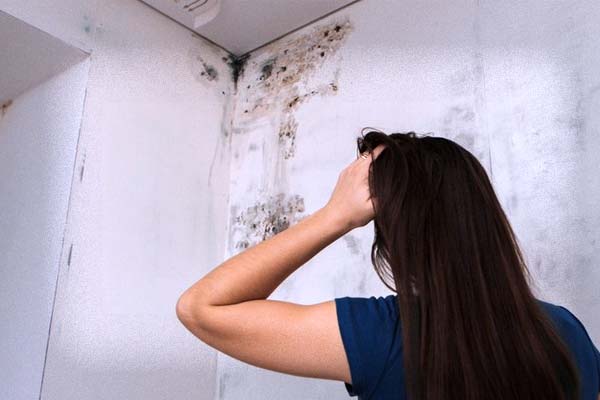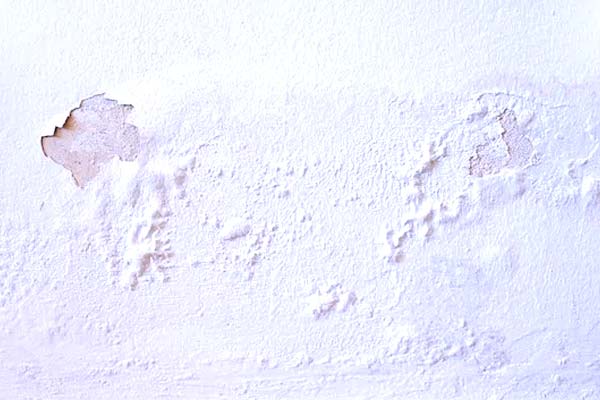Spotting mold early on in your home is crucial for addressing the issue swiftly before it spreads to inaccessible areas and becomes deeply rooted.
There can be several signs to indicate that mold might be growing in your home, they include:
- Damp areas
- Musty smells
- Constant allergy-like symptoms
- Black spots on surfaces
- Flaking paint
If you get to know some of the more common signs of mold growth, it can be much easier to nip this fungus in the bud before it takes root in your home.
Mysterious-looking patches on walls, floors, and ceilings

One of the more obvious indications of excessive mold growth is an unsightly patch or patches that can appear on any surface in your home. While different types of mold will have different textures and appearances, if you find an unusual patch growing in your home, it is likely to be mold, particularly if it is growing in a damp room or area.
Mold growths can range in color, from the more common black, grey, or green, to the less common white, yellow, or even orange. Mold can have a fuzzy or velvety texture, and will often appear as a patch of small dots.
Unsurprisingly for a living organism, it is also likely that this patch will grow over time if it is not addressed quickly.
You should keep an eye out for these patches or growths in damp or moist areas of your home, such as the bathroom or laundry. If you live in a particularly humid climate, you might even notice some of these patches growing on your walls, ceiling, or even your furniture!
Peeling wallpaper or paint

If you notice that the wallpaper or paint in your house is peeling, crackling, or has a bubbly appearance, you may have a moisture problem within your walls. As mold thrives in a damp environment and loves to grow on materials such as drywall and wood, this could be a sign that you will soon have a mold problem on your hands.
In this situation, your best bet is to strip back the paint or wallpaper and assess the extent of the damage underneath. Often, you will need to fix the moisture problem before you can begin to remediate any mold that might be growing.
A damp or musty smell in your home

Mold and mildew have a very distinct smell. The presence of this damp, musty odor in your home is another telltale sign that you might have a mold problem on your hands.
Even if you can’t see any visible mold growths in your home, you may still be able to smell them. Mold can grow anywhere, as long as there is moisture present. Hidden mold is a mold growth that is hidden from view, often beneath carpets or behind your walls. If there is a lingering musty smell in your home that you can’t get rid of, you may be dealing with hidden mold.
Your air conditioning or heating smells odd

If you turn your air conditioning or heating system on only to be met with a rush of bad-smelling air, there is a strong likelihood that you have mold growing with the air conditioning or heating system itself.
This can present a substantial risk to your home environment, as the mold spores will spread quickly through the system and be distributed around your home to make new mold growths.
If you are an asthma sufferer or you have a mold allergy, you will also risk constant exposure to mold spores whenever the air conditioning or heating systems are switched on.
Unfortunately, cleaning and remediating these heating, ventilation, and air conditioning systems is a fairly intensive and involved task, and should only be attempted by a professional.
Your allergies or asthma become worse

Perhaps one of the more distressing signs of extensive mold growth in your home comes through the physical symptoms that they cause in susceptible persons.
For people who suffer from mold allergies, prolonged exposure to mold in the home can give rise to a host of symptoms and issues. These include, but are not limited to: difficulty breathing, stuffy, runny noses, red, itchy eyes, and rashes, and psoriasis-like symptoms.
In many circumstances, people with mold allergies may dismiss these symptoms as seasonal allergies or hay fever. However, if you have mold growths in your home that are actually responsible, your symptoms will not go away and may even worsen.
Similar to mold allergy sufferers, people with asthma may experience respiratory difficulty if they are exposed to extensive mold growths for a prolonged period. In some extreme cases, this exposure may even give rise to an asthma attack.
Signs of mold in your house: the final word
As always when it comes to mold, prevention is the best cure. Keeping your home dry, well-ventilated, and free from excess moisture is your best assurance of preventing any mold growths from taking hold.
However, it is not always possible to prevent mold growth. If you keep vigilant and know the key, common signs of mold growth to watch out for, you will be able to address any mold issues before they become too serious.
FAQ's
How do you know if mold is making you sick?
If you suffer from mold allergies, it can be difficult to distinguish between allergy symptoms that are the result of mold exposure and allergy symptoms that are simply the result of hay fever or a seasonal change.
One of the key ways to tell if mold is making you sick is the prolonged, ongoing nature of your symptoms. If you are suffering from a runny nose, red eyes, rashes, and respiratory issues for weeks on end, you may well be under the influence of a mold allergy.
If you are concerned, you can ask your doctor for an allergy test. They can perform blood tests or skin prick tests to determine if you are allergic to mold. If these results come back positive, you may need to engage a professional mold remediator to inspect your home and determine whether there are any mold growths that may be causing your symptoms.
How much does mold inspection cost?
The average cost for a mold inspection in a small to medium house is between $300 and $400. For larger homes, you can expect this price to increase accordingly and may cost anywhere up to $900.
If you wish to have any mold growths found in your home tested in a laboratory, this will incur an additional cost. This step is often unnecessary, as the official guidance from the Centers for Disease Control and Prevention (CDC) states that any visible mold growth in your home should simply be removed, regardless of the type of mold that is growing.
Once you have had your home inspected for mold, you will have all the necessary information to help you decide whether full mold remediation is necessary.
What does mold smell like?
Mold typically has a damp, musty smell. Although it may not be a particularly strong odor, it will be unpleasant and will prove hard to get rid of unless you kill and remove the mold that is causing it.
Mold’s malodorous scent comes from compounds that are released into the air by mold growths. Called microbial volatile organic compounds, these compounds are extremely volatile and get released into the environment very easily.
While the exact effects of microbial volatile organic compounds are unknown, it has been suggested that they can cause a variety of issues, from headaches to nausea.
Are home mold test kits reliable?
As well as their efficacy being questionable, it is debatable as to whether there is even a point to home mold testing kits, or whether they are simply a marketing exercise.
As the official guidance from the CDC states that all mold growths, irrespective of type, should be removed if found in the home, there seems little purpose to purchasing a home mold testing kit and using it on a mold growth that will be removed in any case.
If you find mold growth in your home, the best course of action is to have it removed. If it is a relatively small growth, you may be able to remove it yourself with a few common household cleaners and equipment.
If the mold growth is more extensive, however, you may need to engage the services of a professional mold remediator.







